The “K” LINE Group is developing human resources and shaping workplace environments with the aim of allowing all employees to heighten their skills and achieve greater results. Our approach toward career planning positions the first 10 years after joining the Company as one leg of an employee’ s career, during which they should be provided with various experiences and opportunities to learn, equipping them to develop their careers through on-the-job experience. After the first 10 years, employees move on to a stage at which they are expected to build on their specialties, with an emphasis on autonomy, and to gain management skills and pursue career development. We have also prepared a number of training programs to help employees acquire the skills needed for their specific career plans.
• Nurturing individuals who have professional knowledge, high management skills, and integrity
• Maintaining a corporate culture that appreciates mutual respect, freedom, and vigor; these traits enable each employee to use their ability proactively and allow the organization to overcome difficulties and grow continuously
• Creating an environment where employees share what the Company should be in the future and keep nurturing new abilities
• Establishing efficient business procedures that bring maximum results with minimum effort; accordingly, employees can enjoy both work and life
In order to provide safe and optimized transportation services, which is the core of the “K” LINE Group’s business management, it is important to secure maritime officers and to foster them effectively. To attract diverse human resources, we dispatch our maritime officers to various maritime universities and schools to participate in lectures and round-table discussions. We also welcome interns from various schools in an effort to spark their broad interest in becoming maritime officers. In addition, we take on people from non-maritime universities and train them in-house to become maritime officers.
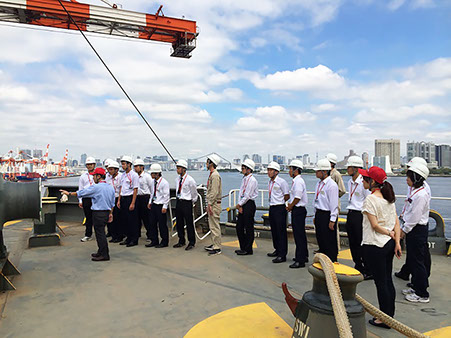
Our maritime officers do much more than work as captains, deck officers, chief engineers, or engineering officers on ships. They make full use of their high-level skills, knowledge, and experience gained through work on board vessels for a variety of activities that are indispensable to providing safe and optimized services onshore. To enable maritime officers to demonstrate their full potential, we not only provide numerous technical training courses but also conduct stratified training. This training enables the Company and its maritime officers to fulfill their potential with common objectives in mind.
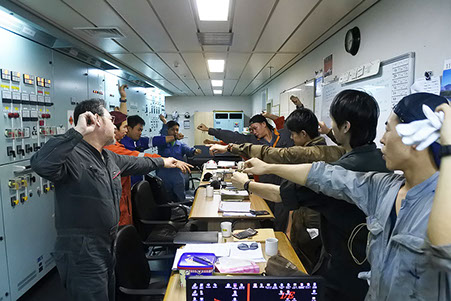
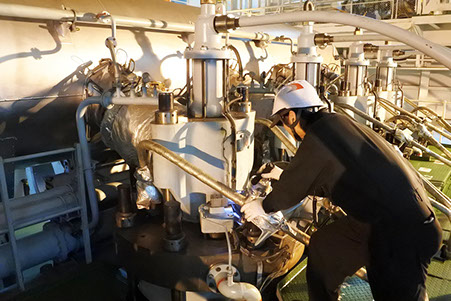
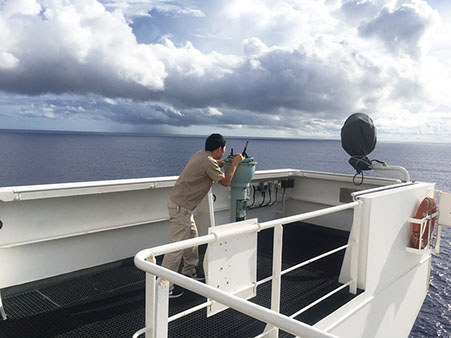
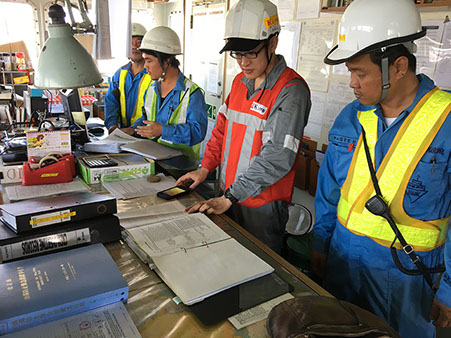
“K” LINE’s training structure for human resource development was designed with the goal of developing human resources who embody the values “K” LINE requires for the realization of its corporate principle and vision.
The training program was primarily designed with the aim of enhancing four types of skills. Although those skills—core skills, practical maritime skills, general skills, and management skills—can be improved through work, we prepared this training program to encourage growth in employees. The training program is mainly divided into position-based training and maritime training for young employees, management training for managers, and general training for all employees.
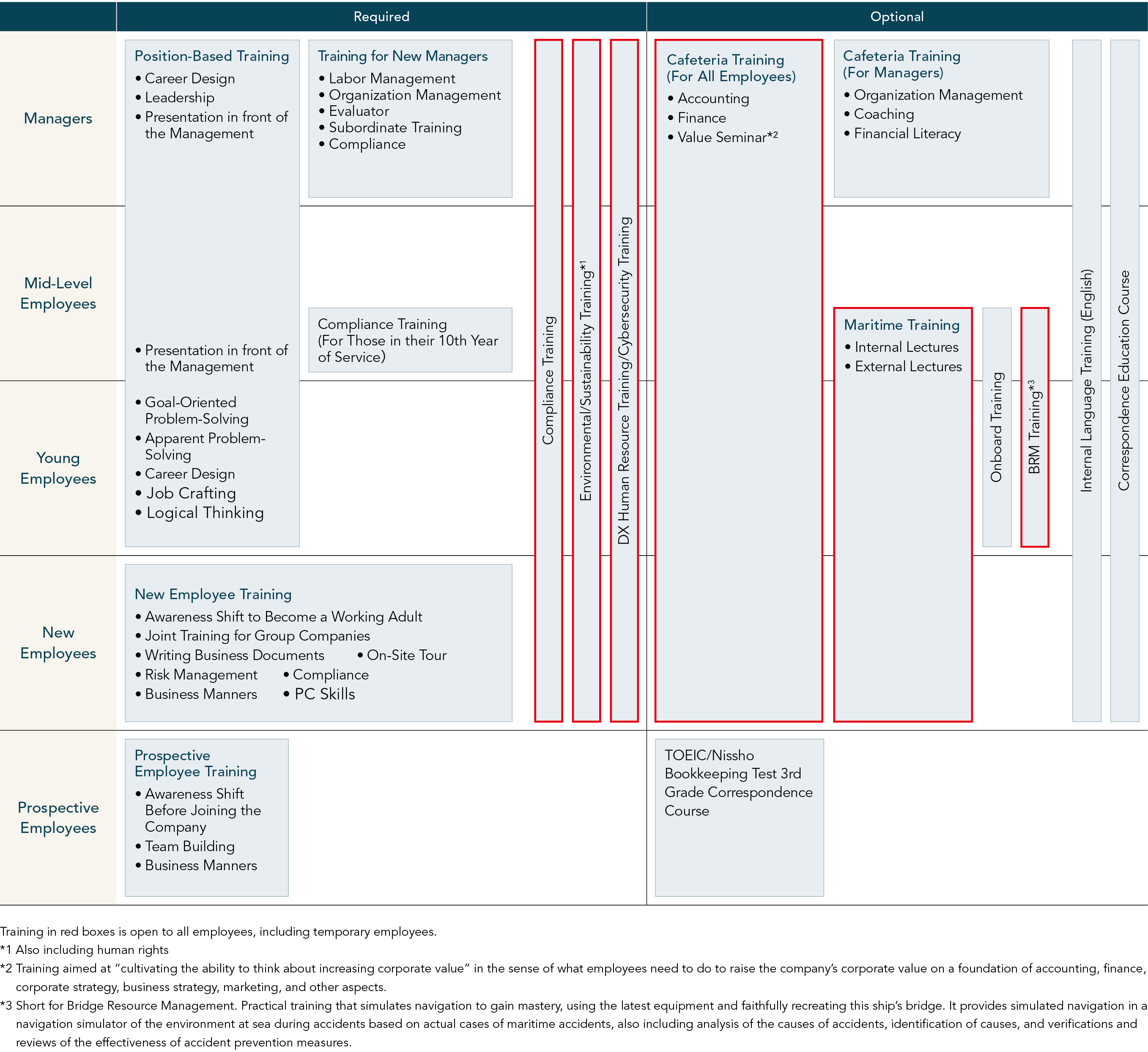
“K” LINE aims to make employees professional shipping executives, a source of differentiation and growth for the Company, by taking into account the efforts and contributions of each employee in their evaluations based on its personnel evaluation system. Our personnel evaluation system measures individual performance in the context of target management and behavioral assessments, and reflects these criteria fairly and transparently in their evaluations.
1) Target management: At the beginning of the fiscal year, the goals that contribute toward achievement of the Company’s earnings targets are set for all employees in accordance with the size of their roles and responsibilities, based on their job grades. At the end of the fiscal year, their achievement of these goals is assessed.
2) Behavioral assessments: At the end of the fiscal year, employees are assessed on whether they have reached a state where they are able to consistently demonstrate the behavior required for their job grades.
To increase the level of each employee’s satisfaction with the outcome of their evaluation, it is necessary for managers to communicate adequately with their employees. At “K” LINE, opportunities are created for such communication in April (to verify first-half targets and behavior required for the fiscal year), in October (progress toward first-half targets, a review of behavior required for each job grade, and confirmation of targets for the second half of the fiscal year), and in March (feedback is provided on two occasions, once before the evaluation and once after the evaluation). In particular, the communication before the evaluation at the end of the fiscal year is positioned as an important process for enhancing mutual understanding based on objective facts, not just impressions and fragmented information.
Our human resource evaluation systems cover 100% of full-time employees.
The “K” Line Maritime Academy (KLMA) is a generic term for our educational philosophy, which includes educational policies for fostering personnel indispensable to implementing the Group’s basic commitment to “safety in navigation and the protection of human lives, cargoes, and the natural environment at sea.” These personnel include seafarers (officer and rating) and maritime officers (“K” LINE seafarers) who have the knowledge and skills that enable them to excel in onshore duties (ship management, crew management and training, and sales division support).
Under the KLMA, we foster maritime officers according to our KLMA Master Plan and transfer knowledge of the Group’s maritime technical expertise, amassed over many years, to the next generation. All Group companies are united in the goal of fostering exceptional maritime officers.
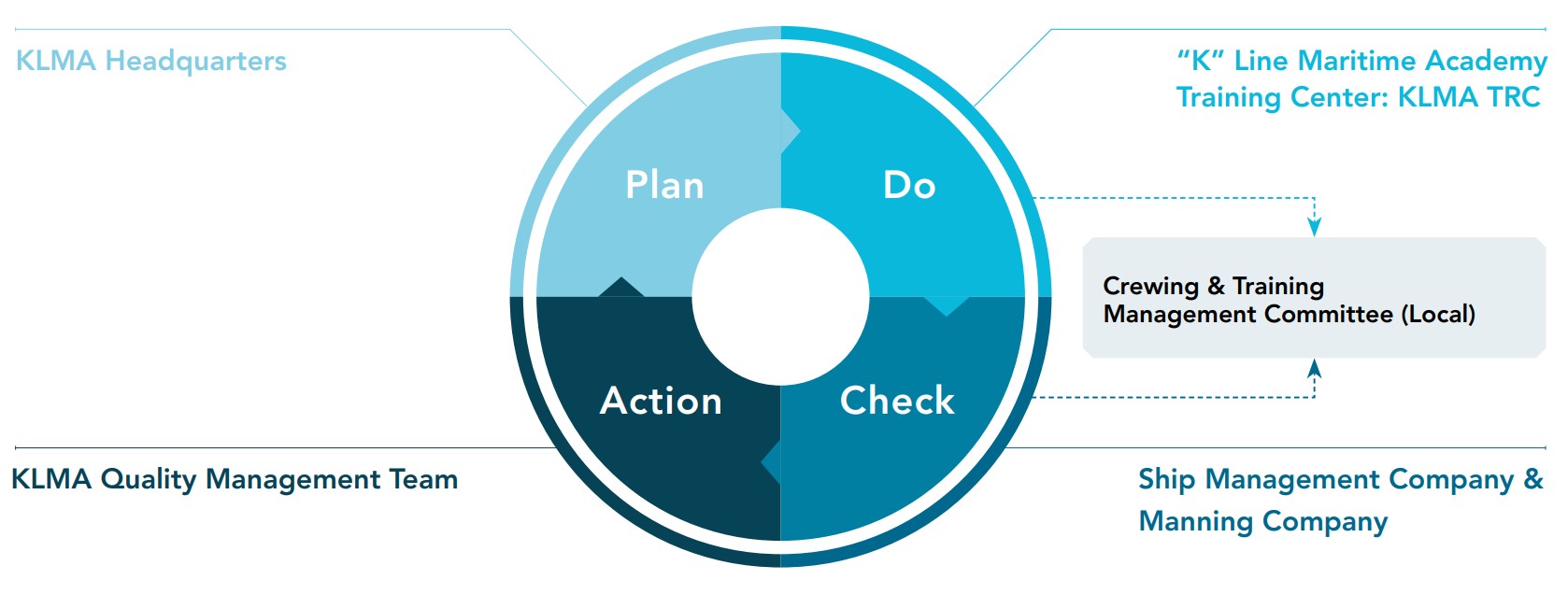
Exercising “K” LINE’s corporate principle and vision requires the development of human resources who can practice teamwork in their daily activities to give form to the “K” LINE spirit (independence and autonomy, broad-mindedness, and an enterprising spirit), which has supported our ambitions and value creation for a century, and the six values the "K" LINE GROUP prized. In the current era, which is characterized by volatility, uncertainty, complexity, and ambiguity, “K” LINE will continue to foster maritime professionals who can compete on the global stage. We are committed to developing human resources so that they can become professionals with a propensity for self-growth—with a continual awareness of how circumstances affect them no matter how the operating environment may change—and to making them proficient at coordinating their work with others.
“K” LINE offers stratified training programs for each level of employee to learn the fundamental skills and ways of thinking required by businesspeople playing important roles in global businesses. In particular, employees who join as new graduates must take these programs each year for their first five years with the Company.
We implement training for learning specialized knowledge of the marine transportation business, such as an explanation of operations by each department head, the structure of vessels, insurance, clerical duties, bills of lading, and the environment, to enable employees to grow in the most important training period and intensively acquire maritime skills.
Managers are expected to maximize the performance of their organization and fulfill their roles. To ensure this, we implement training for managers with the aim of acquiring management skills that ensure psychological safety by respecting individual diversity, increasing self-efficacy, and providing a comfortable place to work. Additionally, we implement labor management and compliance training to ensure compliance with laws.
We implement training with the aim of acquiring knowledge of accounting, finance, English, and IT. We aim to develop human resources capable of understanding “K” LINE’s current corporate value and considering measures for its enhancement by looking at the Company from a general perspective.
(※)A method that allows employees to select the seminars they want to participate in from a number of topics.
We carry out an impartial comparison of goals set by employees and their actual achievements. Evaluation results are fed back to each staff member to improve the transparency of the evaluation process and to encourage their development. We assist this development primarily with two programs: on-the-job training (OJT) for mastering knowledge, skills, and procedures on-site and job class-specific group training (OFF-JT). Other training programs we offer include in-house language training, training at our overseas subsidiaries, and assistance for employees taking correspondence courses for personal development. We also provide onboard training for our onshore workers, a program specifically tailored for shipping companies. This helps individual participants improve their skills by providing them with a variety of opportunities, including experiencing work performed by seafarers on ships at sea.
“K” LINE Group employees from all over the world are invited to our “K” LINE UNIVERSITY training sessions, which are held annually in Tokyo. These training sessions deal with themes such as the “K” LINE Group’s vision and its future business development. “K” LINE UNIVERSITY provides participants with a valuable opportunity to speak face-to-face with colleagues they would usually communicate with through mostly online tools, and to deepen their shared understanding.
Securing maritime officers is important for providing safe and optimal transportation services. Seeking to secure diverse human resources, we dispatch our maritime offiers to give lectures at various maritime universities and schools. We also accept internships from various schools to encourage a broader interest in the work of maritime officers, and we engage in the training of individuals from non-maritime universities to foster them as maritime officers at the Company.
We introduced the in-house maritime officers training program for university graduates outside of maritime-related universities since 2013. Graduates of regular universities are required to participate in a two-year training program at the Maritime Technical College managed by the Japan Agency of Maritime Education and Training for Seafarers. Under this program, graduates attend classroom and practical training, onboard training on training vessels, basic training at our training center, and onboard training on “K” LINE operated vessels. If the graduates pass the National Third Grade Marine Officer examination, they are appointed as a third officer or a third engineer. Following this, they will be able to build a career as maritime officers in the same manner as graduates from a maritime-related university and experience work as an onshore employee, including at overseas offices, in addition to working as deck officers and engineering officers on board our vessels.
Maritime officers experience closed living conditions when working offshore. As soon as our maritime officers disembark after an offshore stint, they participate in telephone interviews with HR personnel to discuss their lives on board the ship, as well as personal relationships and anything else that comes to mind. When necessary, we also conduct face-to-face interviews. Through these efforts, we endeavor to not only relieve anxiety among our maritime officers but also gain a better understanding of conditions on the front lines.
Under the “K” Line Maritime Academy (KLMA), we conduct various training programs to foster maritime officers (“K” LINE Seafarers) with essential knowledge and skills to implement the “K” LINE Group’s basic commitment to safety in navigation and the protection of human lives, cargoes, and the natural environment at sea. As part of our seafarers’ training, we have introduced a state-of-the-art ship maneuvering simulator to help trainees respond to re-enacted accidents and the like. For institutional training, KLMA (the Philippines) conducts training using an actual main engine to help trainees obtain knowledge of and skills in new technologies. In these ways, Group companies are united in their quest to develop excellent maritime officers.
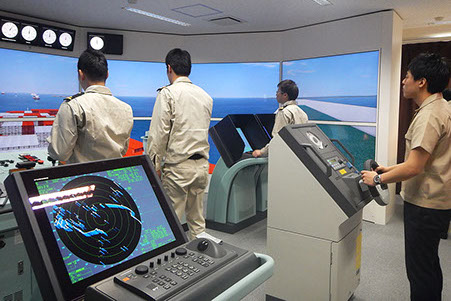
- 拡大
- KLMA (Japan) Machida Training Center
Training using ship handling simulator
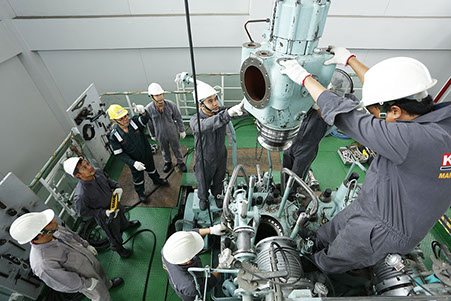
- 拡大
- KLMA(Philippines)
Training using actual Main Engine
KLMA is based on the KLMA Master Plan for preserving the Group’s seamanship, which we have cultivated over many years, for the next generation. We will reliably preserve the knowledge and skills that support safety in navigation and environmental preservation and “K” LINE’s business foundation, as well as meet the needs of a new era, such as advanced technology. Specifically, our maritime officers undergo onshore training at our six training facilities, in Japan, Philippines, India, Bangladesh, Eastern Europe, and Central Europe, and onboard training programs. They also receive advancement in both onshore and offshore careers. KLMA (Philippines) is positioned as the core of training for Filipino seafarers, who comprise approximately 70% of “K” LINE Group crew members, and it accepts a total of 10,000 seafarers every year.
Furthermore, we have promoted a shift to online training and created a system that enables employees to participate from home.
(This data applies to Kawasaki Kisen Kaisha, Ltd., and its employees.)
|
Item |
Unit |
FY2022 |
FY2023 |
FY2024 |
||
|
Number of employees |
Men |
Onshore |
Persons |
369 |
395 |
421 |
|
Seafarer |
Persons |
201 |
206 |
203 |
||
|
Total |
Persons |
570 |
601 |
624 |
||
|
Women |
Onshore |
Persons |
228 |
240 |
269 |
|
|
Seafarer |
Persons |
6 |
6 |
7 |
||
|
Total |
Persons |
234 |
246 |
276 |
||
|
Total |
Onshore |
Persons |
597 |
635 |
690 |
|
|
Seafarer |
Persons |
207 |
212 |
210 |
||
|
Total |
Persons |
804 |
847 |
900 |
||
|
Percentage of Women |
Onshore |
% |
38.19 |
37.8 |
38.99 |
|
|
Seafarer |
% |
2.90 |
2.83 |
3.33 |
||
|
Total |
% |
29.10 |
29.04 |
30.67 |
||
|
Employees in management positions |
Men |
Persons |
126 |
124 |
125 |
|
|
Women |
Persons |
10 |
9 |
10 |
||
|
Percentage of Women |
% |
7.35 |
6.77 |
7.41 |
||
|
Employees in management positions (general managers or higher) |
Men |
Persons |
27 |
26 |
30 |
|
|
Women |
Persons |
0 |
0 |
1 |
||
|
Percentage of Women |
% |
0.00 |
0.00 |
3.23 |
||
|
Directors (including officers) |
Men |
Persons |
26 |
28 |
26 |
|
|
Women |
Persons |
2 |
2 |
2 |
||
|
Percentage of Women |
% |
7.14 |
6.67 |
7.14 |
||
|
Percentage of employees with disabilities (※1) |
% |
1.71 |
2.11 |
2.65 |
||
|
Average years employed(※2) |
Men |
Years |
14.92 |
14.58 |
14.23 |
|
|
Women |
Years |
13.77 |
13.52 |
13.18 |
||
|
Labor union participation rate |
Onshore |
% |
75.90 |
76.54 |
72.90 |
|
|
Seafarer |
% |
74.90 |
74.16 |
74.10 |
||
|
Gender pay gap(※3) |
All employees |
% |
57.7 |
59.0 |
63.7 |
|
|
Full-time employees |
% |
58.9 |
60.7 |
65.4 |
||
|
Part-time employees |
% |
44.5 |
41.0 |
48.7 |
||
- These figures conform to the Act to Facilitate the Employment of Persons with Disabilities. According to the Act, a 90% exclusion rate applies to and is calculated for seafarers (excluding those on duty onshore).
- The scope of reporting covers “K” LINE’s permanent employees
- Calculation method: Average annual salary for women / Average annual salary for men
|
item |
unit |
FY2022 |
FY2023 |
FY2024 |
|||
|
Recruitment of new graduates |
Men |
Onshore |
Persons |
19 |
26 |
30 |
|
|
Seafarer |
Persons |
13 |
18 |
23 |
|||
|
Total |
Persons |
32 |
44 |
53 |
|||
|
Women |
Onshore |
Persons |
7 |
15 |
12 |
||
|
Seafarer |
Persons |
3 |
1 |
1 |
|||
|
Total |
Persons |
10 |
16 |
13 |
|||
|
Total |
Onshore |
Persons |
26 |
41 |
42 |
||
|
Seafarer |
Persons |
16 |
19 |
24 |
|||
|
Total |
Persons |
42 |
60 |
66 |
|||
|
Percentage of Women |
Onshore |
% |
26.92 |
36.59 |
26.19 |
||
|
Seafarer |
% |
18.75 |
5.26 |
4.17 |
|||
|
Total |
% |
23.81 |
26.67 |
19.70 |
|||
|
Mid-career hires |
Men |
Onshore |
Persons |
7 |
13 |
14 |
|
|
Seafarer |
Persons |
1 |
1 |
0 |
|||
|
Total |
Persons |
8 |
14 |
14 |
|||
|
Women |
Onshore |
Persons |
5 |
3 |
7 |
||
|
Seafarer |
Persons |
0 |
0 |
0 |
|||
|
Total |
Persons |
5 |
3 |
7 |
|||
|
Total |
Onshore |
Persons |
12 |
16 |
21 |
||
|
Seafarer |
Persons |
1 |
1 |
0 |
|||
|
Total |
Persons |
13 |
17 |
21 |
|||
|
Percentage of Women |
Onshore |
% |
41.67 |
18.75 |
33.33 |
||
|
Seafarer |
% |
0.00 |
0.00 |
0.00 |
|||
|
Total |
% |
38.46 |
17.65 |
33.33 |
|||
|
Total number of newly hired employees |
Total |
Persons |
55 |
77 |
87 |
||
|
Men |
Onshore |
Persons |
26 |
39 |
44 |
||
|
Seafarer |
Persons |
14 |
19 |
23 |
|||
|
Total |
Persons |
40 |
58 |
67 |
|||
|
Women |
Onshore |
Persons |
12 |
18 |
19 |
||
|
Seafarer |
Persons |
3 |
1 |
1 |
|||
|
Total |
Persons |
15 |
19 |
20 |
|||
|
Breakdown by age group |
Onshore |
Under 25 years old |
Persons |
22 |
40 |
23 |
|
|
25-29 years old |
Persons |
8 |
10 |
26 |
|||
|
30-34 years old |
Persons |
6 |
5 |
7 |
|||
|
35-39 yesrs old |
Persons |
2 |
2 |
7 |
|||
|
40-44 years old |
Persons |
0 |
0 |
0 |
|||
|
45-49 years old |
Persons |
0 |
0 |
0 |
|||
|
50 years old and over |
Persons |
0 |
0 |
0 |
|||
|
Seafarer |
Under 25 years old |
Persons |
16 |
18 |
20 |
||
|
25-29 years old |
Persons |
1 |
1 |
4 |
|||
|
30-34 years old |
Persons |
0 |
1 |
0 |
|||
|
35-39 yesrs old |
Persons |
0 |
0 |
0 |
|||
|
40-44 years old |
Persons |
0 |
0 |
0 |
|||
|
45-49 years old |
Persons |
0 |
0 |
0 |
|||
|
50 years old and over |
Persons |
0 |
0 |
0 |
|||
|
Percentage of Women |
Onshore |
% |
31.58 |
31.58 |
30.16 |
||
|
Seafarer |
% |
17.65 |
5.00 |
4.17 |
|||
|
Total |
% |
27.27 |
24.68 |
22.99 |
|||
|
Item |
Unit |
FY2022 |
FY2023 |
FY2024 |
||
|
Employees retiring |
Total |
Persons |
38 |
33 |
31 |
|
|
Of which, reached retirement age |
Onshore |
Persons |
11 |
4 |
6 |
|
|
Seafarer |
Persons |
4 |
2 |
7 |
||
|
Total |
Persons |
15 |
6 |
13 |
||
|
Of which, voluntary retirement |
Onshore |
Persons |
7 |
12 |
8 |
|
|
Seafarer |
Persons |
9 |
5 |
4 |
||
|
Total |
Persons |
16 |
17 |
12 |
||
|
Of which, involuntary retirement |
Onshore |
Persons |
6 |
7 |
2 |
|
|
Seafarer |
Persons |
1 |
1 |
0 |
||
|
Total |
Persons |
7 |
8 |
2 |
||
|
Of which, others (including those who became officers) |
Onshore |
Persons |
7 |
2 |
3 |
|
|
Seafarer |
Persons |
1 |
0 |
1 |
||
|
Total |
Persons |
8 |
2 |
4 |
||
|
Turn Over Rate |
Turnover rate of "K" LINE(※1) |
% |
3.99 |
3.31 |
2.94 |
|
|
Breakdown by age group |
Under 25 years old |
% |
6.52 |
3.03 |
0.00 |
|
|
25-29 years old |
% |
6.52 |
24.24 |
9.68 |
||
|
30-34 years old |
% |
10.87 |
9.09 |
3.23 |
||
|
35-39 yesrs old |
% |
8.70 |
3.03 |
12.90 |
||
|
40-44 years old |
% |
2.17 |
6.06 |
6.45 |
||
|
45-49 years old |
% |
2.17 |
0.00 |
9.68 |
||
|
50 years old and over |
% |
63.04 |
54.55 |
58.06 |
||
|
Breakdown by gender |
men |
% |
86.96 |
81.82 |
77.42 |
|
|
women |
% |
13.04 |
18.18 |
22.58 |
||
|
Ratio of voluntary resignations(※2) |
% |
1.68 |
1.71 |
1.14 |
||
|
Breakdown by age group |
Under 25 years old |
% |
18.75 |
5.88 |
0.00 |
|
|
25-29 years old |
% |
18.75 |
47.06 |
25.00 |
||
|
30-34 years old |
% |
31.25 |
17.65 |
8.33 |
||
|
35-39 yesrs old |
% |
25.00 |
5.88 |
33.33 |
||
|
40-44 years old |
% |
6.25 |
11.76 |
16.67 |
||
|
45-49 years old |
% |
0.00 |
0.00 |
8.33 |
||
|
50 years old and over |
% |
0.00 |
11.76 |
8.33 |
||
|
Breakdown by gender |
men |
% |
87.50 |
70.59 |
58.33 |
|
|
women |
% |
12.50 |
29.41 |
41.67 |
||
|
Rate of turnover within three years after hire(New graduates)(※3) |
Onshore |
% |
0.00 |
2.17 |
0.93 |
|
|
Seafarer |
% |
6.52 |
1.89 |
0.00 |
||
|
Total |
% |
2.36 |
2.07 |
0.60 |
||
|
Rate of turnover within three years after hire (New graduates and mid-career hires)(※4) |
Onshore |
% |
0.00 |
2.50 |
0.65 |
|
|
Seafarer |
% |
6.38 |
1.82 |
0.00 |
||
|
Total |
% |
2.13 |
2.29 |
0.46 |
||
|
Turnover rate of employees aged 30 or younger |
% |
2.53 |
3.22 |
1.16 |
||
- Calculation method: Number of employees who resigned in each fiscal year / Total number of full-time employees at the end of each fiscal year
- Calculation method: Number of employees who resigned voluntarily in each fiscal year / Total number of full-time employees at the end of each fiscal year
- Calculation method: Number of new graduates employees hired in the previous three fiscal years who resigned in each fiscal year / Number of new graduates employees hired in the previous three fiscal years
- Calculation method: Number of new graduates and mid-career employees hired in the previous three fiscal years who resigned in each fiscal year / Number of new graduates and mid-career employees hired in the previous three fiscal years
|
Item |
Unit |
FY2022 |
FY2023 |
FY2024 |
||
|
Training |
Cost of training per employee |
Onshore |
Yen |
97,092 |
171,454 |
208,861 |
|
Seafarer |
Yen |
263,880 |
393,407 |
410,222 |
||
|
Total amount of time spent on employee development training |
Onshore |
Hours |
15,066 |
13,621 |
14,590 |
|
|
Seafarer |
Hours |
20,080 |
32,344 |
30,344 |
||
|
Average training days per employee |
Onshore |
Days |
3.4 |
3.0 |
3.0 |
|
|
Seafarer |
Days |
12 |
20 |
18 |
||
|
Average training hours per employee |
Onshore |
Hours |
24.1 |
20.9 |
21.3 |
|
|
Seafarer |
Hours |
96 |
160 |
144 |
||
